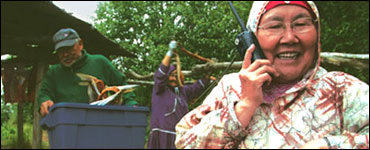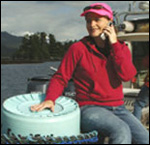CDC Features
Current Features
Alaska Breast & Cervical Cancer Early Detection Programs: Partners for Success

Historically there have been significant geographic and cultural barriers to breast and cervical cancer screening in Alaska. The state is enormous, covering over 586,000 square miles. About 30% of the state’s population lives in very rural communities. Many travel 200 to 500 miles for healthcare services. Alaska is also an ethnically diverse state that has 229 federally recognized tribes and 119,241 Alaska Native residents according to the 2000 US Census. Census data also indicate as many as 55,000 women in Alaska between the ages of 18 and 64 may be at or below 250% of the poverty level and nearly 30,000 in this age range are without any type of health insurance.

The Centers for Disease Control and Prevention's National Breast and Cervical Cancer Early Detection Program (NBCCEDP) funds five programs in Alaska:
• Arctic Slope Native Association/North Slope Borough (ASNA)
• Breast & Cervical Health Check Program (BCHC)
• Southcentral Foundation (SCF)
• Southeast Regional Health Consortium (SEARHC)
• Yukon Kuskokwim Health Corporation (YKHC)
Prior to 2001, the five grantees worked individually to provide the best screening for underserved women that they could, but they were unsuccessful in providing continuity of care between regions or maximizing resources. Idea and opportunity sharing did not exist and program directors operated in vacuums, unable to identify and capitalize on the support and resources within the state.
Working Together for Success
In 2001, these five Alaskan programs began looking for ways to work together. Small efforts grew into a formal partnership. While each of the partners maintains its own separate programs, they also work together as the Alaska Breast & Cervical Health Partnership to ensure the best possible breast and cervical health screening services for women throughout Alaska. By 2003, collective work began on nearly every NBCCEDP component: recruitment; professional development; surveillance and evaluation; screening/diagnosis and treatment; and quality assurance and improvement.

As a result of regular communication and ongoing collaborative efforts, the Alaska Breast & Cervical Health Partnership has successfully completed the following major projects:
• New breast cancer screening guidelines
• Coordinated professional education opportunities for clinicians
• Joint public education messages
The following activities are planned or are in progress:
• Development, production and statewide distribution of new cervical cancer screening guidelines
• Participation in an HPV vaccine/cervical cancer study
• Distribution of information to Alaska State Legislators and national Congressional delegates to raise awareness of the NBCCEDP’s impact
• Development, production, and distribution of a statewide “survivor” calendar featuring breast and cervical cancer survivors from each NBCCEDP grantee
• Expansion of the Partnership to include collaboration with the two Alaskan-based Comprehensive Cancer Control Programs and the American Cancer Society-Alaska
• Modification of the annual statewide Behavioral Risk Factor Surveillance System (BRFSS) survey to include questions on barriers to screening
While each of the NBCCEDP grantees in Alaska is unique and targets different cultural and ethnic groups, there is a collective knowledge shared by the Partnership. Eliminating duplication of efforts and collaborating to maximize strengths has helped to build both individual programs and a collective statewide infrastructure for outreaching, educating, screening and diagnosing underserved Alaskan women. Collectively, these five programs have detected 310 breast cancers, 31 invasive cancers, and nearly 900 precancerous cervical conditions. They currently serve over 18,000 women each year.
For More Information
Page last updated: December 3, 2007
Content source: Division of Cancer Prevention and Control
Content owner: National Center for Health Marketing
URL for this page: www.cdc.gov/Features/CancerProgramsAlaska/

